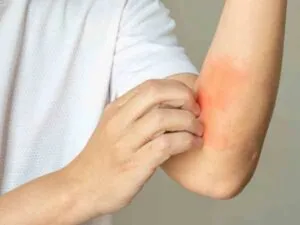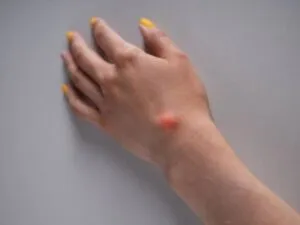Wet Dandruff is a condition where hair becomes dry and flaky due to excessive water loss. Wet Dandruff occurs when the skin loses moisture faster than the hair follicles can replenish it. In some cases, the scalp may become irritated and inflamed. Excess oil production causes hair follicles to become clogged and blocked. When this happens, the hair follicle produces extra sebum (oil) which then falls out of the hair shaft. This is called “wet” dandruff because the flaking skin is oily. Dry dandruff does not have any oil present on the surface of the skin.

There are several types of dandruff. These include:
- Dry dandruff – flakes fall off easily and leave the scalp feeling dry.
- Oily dandruff – flakes tend to stick together and feel greasy.
- White flaky dandruff – white flakes appear on the surface of the scalp.
- Black dandruff – black flakes appear on the surface.
- Crusty dandruff – crusty flakes appear on the surface and become hard.
- Powdery dandruff – flakes look like fine sand.
- Flaking dandruff – flakes break apart easily.
A person can develop dandruff if they do not wash their hair regularly. Washing the hair helps remove excess oils and dirt. If a person does not wash his/her hair enough, then the oil glands in the scalp produce extra oil. When there is too much oil produced, it clogs the pores of the scalp and makes them unable to shed dead skin cells. Over time, these dead skin cells build up on the scalp.
If a person uses shampoo containing sulfates, he/she may cause damage to the scalp. Sulfate-based shampoos strip away the natural oils from the scalp. As a result, the scalp becomes drier and produces even more oil. This cycle continues until the person stops using sulfate-containing shampoo.
Some people believe that dandruff is contagious. However, dandruff is not infectious.
Causes of Wet Dandruff

The cause of wet dandruff is excessive oil production in the scalp, which results in the blockage of the hair follicles. There are two types of oils produced in the scalp; sebaceous oil and apocrine sweat glands. Sebaceous oil is produced bysebocytes, which are cells located near the base of the hair follicles, while apocrine sweat glands produce sweat-like fluid containing fatty substances. These oils help lubricate the hair and keep it soft. However, if these oils get trapped inside the hair follicles, they may start blocking them, causing dryness and itching.
Another possible cause of dandruff is hormonal imbalance. Hormonal changes can affect the balance of moisture levels on your scalp. Women who experience irregular menstrual cycles tend to suffer from dandruff. A good diet can help restore hormone balance.
Some people might also develop dandruff after using certain medications. These drugs can cause dry skin and a flaky scalp. You should talk to your doctor before taking any medication.
Finally, environmental factors play a role in causing dandruff. Exposure to excessive sunlight can damage the hair follicles and lead to dandruff. Also, if you live in hot climates, you’ll likely get dandruff since sweat glands work overtime.
Symptoms of Wet Dandruff

There are many symptoms of wet dandruff. You might notice some of the following:
- Flakes falling off the head
- Hair loss
- Itching
- Scalp irritation
- Redness
- Odor
- Thickening of the hair
How To Treat Dandruff Naturally?

If you want to treat dandruff naturally, first, you should know what triggers it. Once you identify the problem, you can find ways to fix it. Here are some natural remedies to prevent and cure dandruff:
- Wash Your Hair Regularly – The first step to getting rid of dandruff is washing your hair regularly. If you wash your hair less than twice per week, then you may not notice any improvement. However, if you wash your hair at least once a day, then you should start seeing results after about two weeks. Make sure you wash your hair thoroughly and rinse well. You want to make sure that no dirt remains stuck between the strands of your hair.
- Aloe Vera – Aloe vera contains healing compounds that promote hair growth and repair damaged cells. You can use aloe vera gel directly on the affected area. Massage the gel onto your scalp twice daily until you notice results.
- Tea Tree Oil – Tea tree oil works great at treating dandruff. Mix 1 teaspoon tea tree oil with 2 tablespoons olive oil. Apply the mixture to your scalp once a day. Leave it on overnight. Wash off in the morning. Do this treatment regularly for the best results.
- Use A Shampoo That Is Right For You – There are several types of shampoos out there, each designed to treat certain problems. When choosing a shampoo, look for one that contains ingredients that will help prevent dandruff. Look for products that have anti-dandruff agents, moisturizing oils, and mild cleansers. You don’t need to spend a lot of money on good shampoo; just choose one that works best for you.
- Dry Your Scalp After Washing – After washing your hair, dry your scalp completely before applying anything else. You do not want to apply anything directly to damp hair. Once your scalp is dry, apply a small amount of oil to your hair. Be careful not to overdo it, though. Too much oil can cause your hair to become greasy.
- Apply Conditioner – Conditioner helps to restore the moisture balance of your hair. It adds shine and softness while protecting your hair from damage caused by excessive exposure to sunlight. Applying conditioner to your hair after washing it will help to eliminate excess water and leave your hair feeling smooth and silky.
- Avoid Using Hot Water – Hot water dries out your hair, causing it to lose its elasticity. Instead of hot showers, try taking cold baths instead. Cold water opens up your pores and makes it easier for your body to absorb the nutrients in your shampoo.
- Try Not To Overwash – Overwashing your hair causes it to break down faster. By rinsing your hair too often, you strip away the protective layer of oils that keeps your hair looking shiny and healthy.
The Difference Between Dry Dandruff & Wet Dandruff

A dry scalp is often caused by a lack of moisture in the hair follicles. Dry skin can also occur due to excessive use of harsh chemicals and products. A wet scalp is generally caused by excess oil production in the sebaceous glands. Both conditions can lead to itching and flaking of the scalp. However, the cause of these two different types of dandruff is quite different.
The first condition is called “dry dandruff” and occurs when the skin cells become dehydrated and lose their protective oils. As a result, they start to break down and fall off. These dead skin cells accumulate on the surface of the scalp and create flakes.
On the other hand, “wet dandruff” is caused by an overproduction of oily secretions (sebum) in the sebaceous gland. When the glands produce too much oil, it gets trapped under the skin and clogs the pores. This causes the skin to look greasy and oily and results in white scales.
Both conditions require treatment, but the best way to treat them is to prevent them from occurring in the first place. Here are some tips to help keep your scalp clean and free of dandruff:
•Use a mild shampoo and conditioner.Avoid using shampoos containing sodium lauryl sulfate (SLS), which strips away natural oils and makes the scalp drier. Instead, opt for gentle cleansers that won’t strip the scalp’s natural oils.
•Wash your hair less frequently.If you wash your hair daily, it may actually increase the amount of oil produced by the sebaceous glands and make the problem worse. Try washing your hair only once or twice per week.
•Keep your hair moisturized.Moisturizing treatments work well at preventing dryness and keeping the scalp soft and supple. Look for formulas that contain ingredients like aloe vera, jojoba oil, avocado oil, shea butter, coconut oil, olive oil, etc.
•Don’t rub your scalp.Rubbing stimulates the sebaceous glands, causing them to produce even more oil. In addition, rubbing increases friction between the scalp and the strands of hair, making it easier for flakes to stick to the scalp.
•Shampoo gently.Using a strong shampoo can irritate the scalp and cause further damage.
•Be careful about what you put on your head.Make sure not to apply any lotion, cream, or ointment directly onto the scalp. Doing so could block the pores and trap dirt inside the scalp. Instead, apply the product to your hands and then massage it into your scalp.
•Wear hats.Hats protect your scalp from sun exposure and provide extra protection from wind-blown debris.
If you have already developed dry dandruff, try applying a medicated shampoo. Medicated shampoos are designed to combat the symptoms of dandruff without drying out the scalp. You should avoid shampoos that contain alcohol since they can dry out the scalp.
To get rid of wet dandruff, try using a medicated soap. Soap bars that contain salicylic acid or benzoyl peroxide are effective at treating both forms of dandruff.






